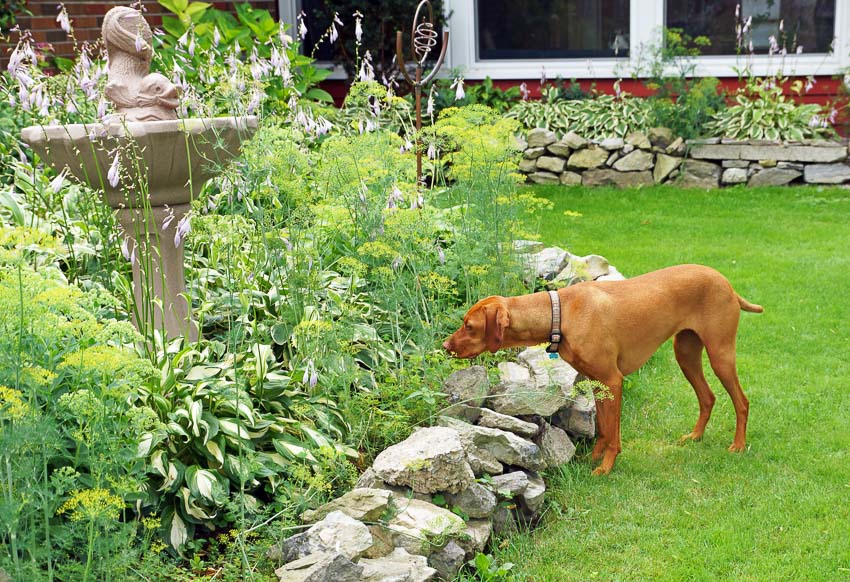You love your dog and enjoy lavishing the care and attention on it that it needs. The same goes for your yard, but it can spell disaster when the two come together. In this guide, you’ll learn how to use dog-friendly landscaping ideas that will make it easier to keep your dog and your yard safe from each other.
Key Considerations for Dog Friendly Landscaping
Sometimes it feels like you have to choose between having a dog and a well-manicured yard, but there’s no reason why you can’t have both. Start by recognizing your dog’s needs in your landscape design.
Recognizing your dog’s needs in the landscape design
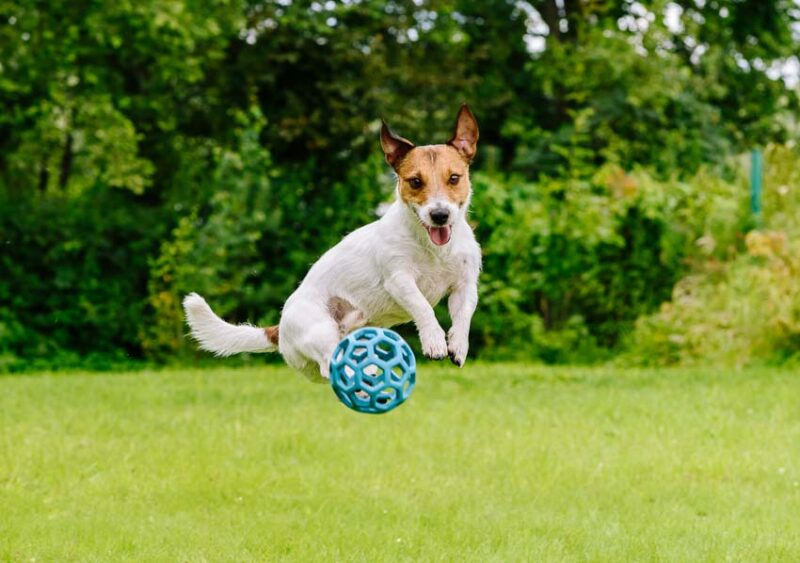
When designing your backyard, it’s natural to use features that you can use, like a lawn or an herb garden. Backyard landscape ideas that consider your dog’s needs make it easier to care for your yard and protect it from dog-related damage.
Designing your yard so it’s dog friendly depends on the type of dog you have, your lifestyle, and how much property you have. There are many different types of dogs, and designing a Pomeranian landscape is completely different from creating the best yard for an Airedale.
However, all dogs have some basic needs:
- Clean, fresh drinking water
- Space to run and play
- Access to shade and protection from the elements
- Secure fencing
- Area for potty breaks
- Plenty of interesting sights, smells, and sounds
- Toys and agility equipment
When you provide these for your dog, it will be happier and healthier, and there will be less conflict between your dog and your landscaping.
Ensuring safety in your dog friendly landscaping
Dog owners worry about their pet’s safety, and keeping them safe is a primary concern. What are some risks your dog is exposed to in your backyard?
- Parasites, like ticks, fleas, and worms
- Toxic plants, like azaleas and tulips
- Animals, including other dogs and pests like skunks and raccoons
- Ingesting or choking on foreign objects, like sticks and mulch
- Heat exhaustion, caused by lack of shade
- Exposure to chemicals, especially after a yard treatment
It’s impossible to mitigate all the risks that threaten your dog, but by making a secure area for your pet and avoiding certain types of plants and mulch, you can go a long way to ensuring your dog’s safety in your backyard.
How to Landscape Without Grass: Dog Friendly Edition,
Some of the worst dog-related damage in your yard is inflicted on your lawn. Whether your dog is digging holes in your lawn or using your grass as a bathroom, you can end up with unattractive bare spots. Try these alternatives for dog friendly landscaping without grass.
Ground cover alternatives to grass
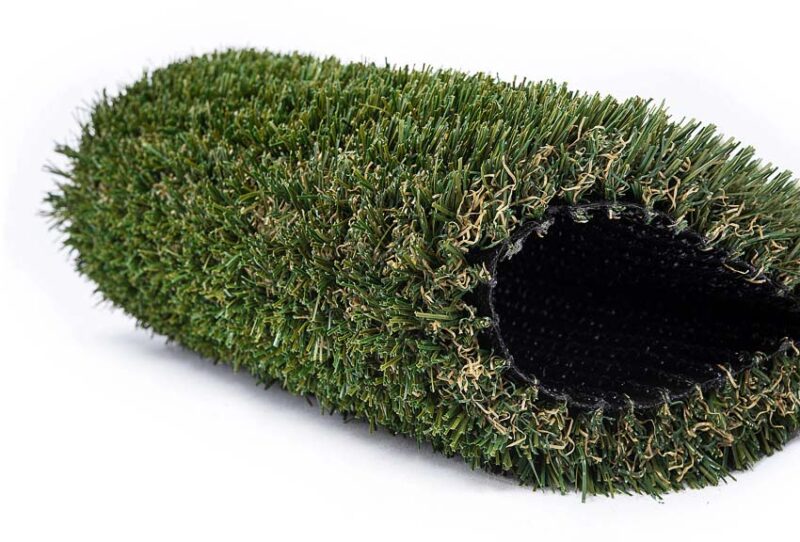
There are many alternatives to grass that you can use in a dog-friendly landscape, and it will make it easier to clean up after your pet’s potty breaks and keep their paws from getting muddy.
| Dog-friendly alternatives to grass | Benefits and use |
| Artificial turf | Choose artificial grass made of polyethylene. It looks real and resists moisture, so it’s less likely to absorb odors. Use rubber infill and wash the area weekly with a hose. |
| Patio pavers | Lay patio pavers to keep your dog from digging in specific areas and tracking mud into your house. |
| Pea gravel | Order bulk pea gravel and spread it in a large area for a dog run. It’s easy on your dog’s paws and has a neat, clean appearance. Wash off pet urine with a hose once a week. |
| Bark mulch | Unless your dog chokes on it, most bark mulch is safe, and dogs find it comfortable to lay in. Avoid cocoa bean mulch, which is toxic for dogs. |
Living ground covers
Many ground covers are less susceptible to dog-related damage than grass. Try these living ground covers for your dog-friendly backyard.
| Dog-friendly ground cover plants | Benefits and uses |
| White clover (Trifolium repens) | Grow in full sun to partial shade. White clover is resistant to dog urine. Plant a clover lawn for an eco-friendly alternative to grass. |
| Silver carpet (Dymondia margaretae) | Grow in full sun to partial shade. It can be grown as a perennial in hardiness zones 9 to 11. |
| Lamb’s ear (Stachys byzantina) | Grow in full sun to partial shade. It grows in large clumps, is hardy in all climates, and tolerates foot traffic. |
| Elfin thyme (Thymus serpyllum) | Grow in full sun. This cultivar is not a culinary species. It grows in low mounds that are resistant to foot traffic. |
| Deadnettle (Lamium species) | Grow in partial shade. Lamium can be invasive because it spreads quickly. It tolerates moderate foot traffic and is drought-tolerant. |
One of the best dog friendly backyard landscaping ideas is planting hardy ground covers that are resistant to foot traffic between large stepping stones to keep them from getting trampled by your dog.
Creating comfortable play and rest areas without grass
Most people like to use their backyard for relaxing and family activities. Dogs are the same, and they also want to play and rest in your backyard. Create areas in your backyard that keep your dog entertained, but also make sure that there are comfortable rest areas.
If your dog is a digger, it will be almost impossible to stop it from digging holes. Go with the flow and make a sandbox for your dog. Use boards to keep the area contained, or use a plastic kiddie pool and fill it with dirt. Keep the ground moist and bury some of your dog’s toys to encourage it to dig there.
One idea for creating a comfortable rest area for your dog is to mix rubber mulch with a polyurethane binder to make a soft, self-draining surface that won’t move around. It’s easy to wash and safe for pets, but be sure to choose a light color so it doesn’t get too hot for your dog’s paws.
Add a small pergola or some shade cloth, and your dog can enjoy its very own rest area.
You can also build a small doggy deck so your dog can watch passersby without pacing by the fence. If they have a good vantage point, they will sit there for hours and watch over your yard, enjoying the scenery.
Dog Friendly Landscaping Ideas
Dogs get bored just like people, and energetic dogs love exploring and playing. You need a proactive approach that offers them a variety of activities to keep them busy without causing complete chaos in your yard.
Landscaping ideas for active dogs
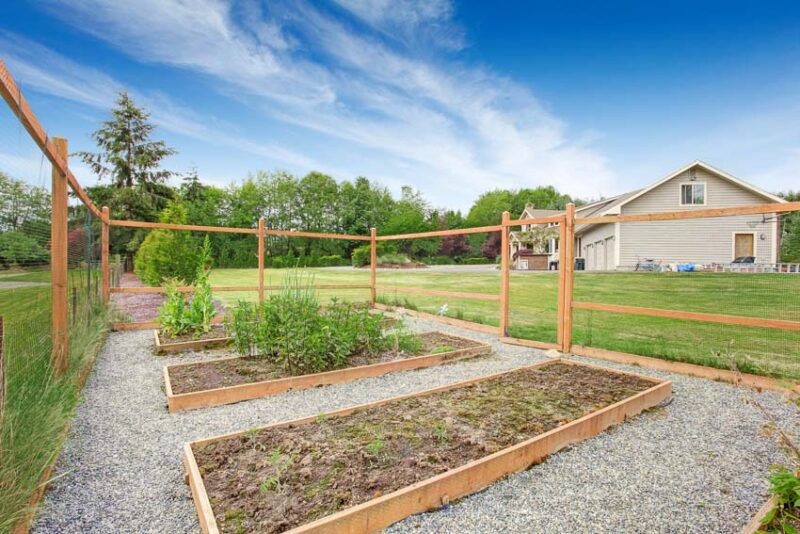
If you’re an avid gardener and a dog lover, you will be forced to make some concessions. Still, the following landscape ideas will make having both an active dog and a beautiful yard easier:
- Use hanging baskets, planter boxes, window boxes, railing planters, and other containers for your expensive plants and delicate flowers.
- Fence off parts of your yard to keep your dog out, like your vegetable garden or pond area.
- Use wire cages to protect trees and shrubs from your dog until they get big enough.
Landscaping ideas for dogs who love to explore
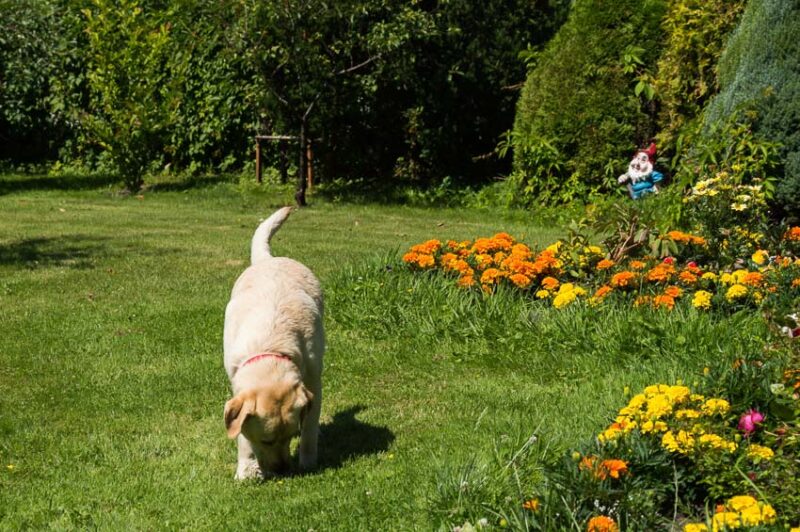
Backyards that are open expanses can seem boring to a dog that likes to explore. Create a landscape berm and plant it with tall shrubs and perennials, then make a curved pathway that goes by points of interest, like your children’s play area, a bird feeder, or a shady spot.
Use resilient plants that are dog friendly in your landscape berm, such as ornamental grasses, herbs, and hardy shrubs such as cotoneaster and juniper. Your dogs can sniff and explore without harming themselves or your flower bed.
Creating water features
Not all dogs love water, but those that do can’t seem to get enough of it. Here are a few ideas to turn your backyard into a dog-friendly water park.
- Puppy pool–use a rigid kiddie pool for your dogs to splash around. It could be the best $20 you ever spent.
- Dog splash pad–buy one premade or make your own. You can build a permanent dog splash pad out of concrete.
- DIY doggo waterfall–use PVC pipe to create a U-shaped waterfall that attaches to a hose. Use two tees with extensions for the base and drill holes across the top so water falls down.
- Dog water fountain–install a paw-activated water fountain so your dog can get a drink whenever they want.
Designing Your Dog Friendly Landscape
Planning is one of the most important parts of any design process, and intentionally designing a dog-friendly landscape will make it easier to incorporate everything your dog needs to enjoy its best life.
Planning for dog paths and exercise areas
Dogs love to patrol your yard, and they probably already have a path worn in their favorite spots, like right along the fence. Instead of fighting against it, lay a path with patio pavers, bricks, bark mulch, or gravel to create pathways for your dog to patrol your yard.
An agility course is a great way to stay fit with your dog, and it doesn’t have to be elaborate to give your dog exercise and mental stimulation. You can build a simple DIY agility course for your dog and spend about 30 minutes daily with them. They’ll enjoy physical exercise, mental stimulation, attention, and treats.
Incorporating dog-friendly plants
It’s important to know what plants are safe for your pets, and there is a surprising number of plants that are toxic to your four-legged friends. Here is a list of plants that you should avoid:
- Azaleas
- Monkshood
- English ivy
- Tulips
- Oleander
- Daffodils
- Foxgloves
- Aloe vera
- Chrysanthemums
- Dahlias
- Daisies
- Irises
- Hostas
That might seem like a list of your favorite plants, but fortunately, there are many dog-friendly choices available. Plant these instead:
- Alyssum
- Coreopsis
- Dill
- Hibiscus
- Petenuias
- Snapdragons
- Sunflowers
- Thyme
Designing for comfort: Shady spots and shelter

If the only shady spot in your yard is where you planted your prized fern, expect it to get flattened on a hot summer day when your black Labrador is trying to cool down. You can avoid instances like these by designing shady spots and sheltered areas for your pups to enjoy.
You’ll have more luck if you make a spot for your dog and plant it with a dog-friendly ground cover that does well in the shade, like carpet bugle (Ajuga reptans) or dead nettle (Lamium species).
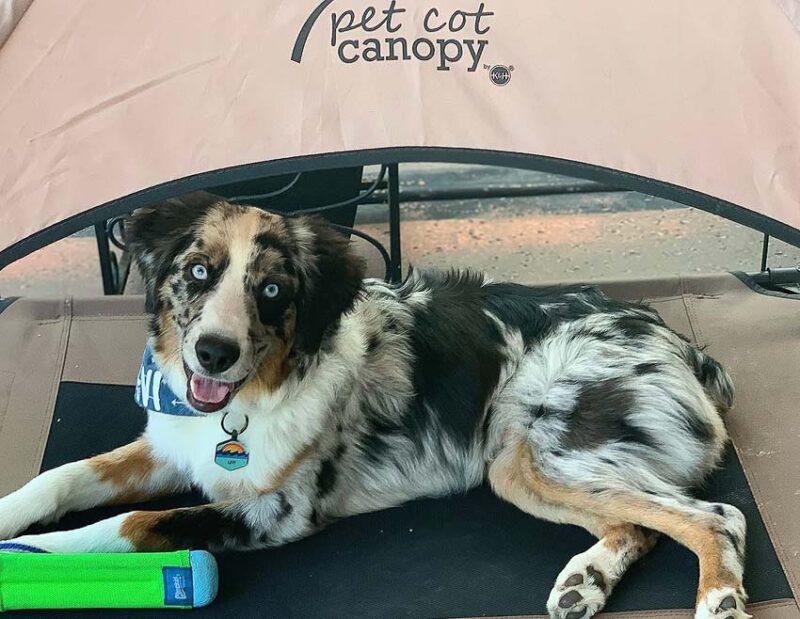
Another cool idea is to lay large flat rocks in a shady area and hose it down once a day during hot weather. You can also place an elevated dog bed with a cover in a cool spot, and it’s guaranteed to be just as comfortable as laying on a fern.
Dog Friendly Landscaping FAQs
What common landscaping plants are toxic to dogs?
Many landscaping plants are toxic to dogs. Most of them cause vomiting or diarrhea, but some can be deadly. The most common and dangerous plants include azaleas, sago palms, lily of the valley, yew, sweet peas, and vinca.
How can I prevent my dog from digging up the landscape?
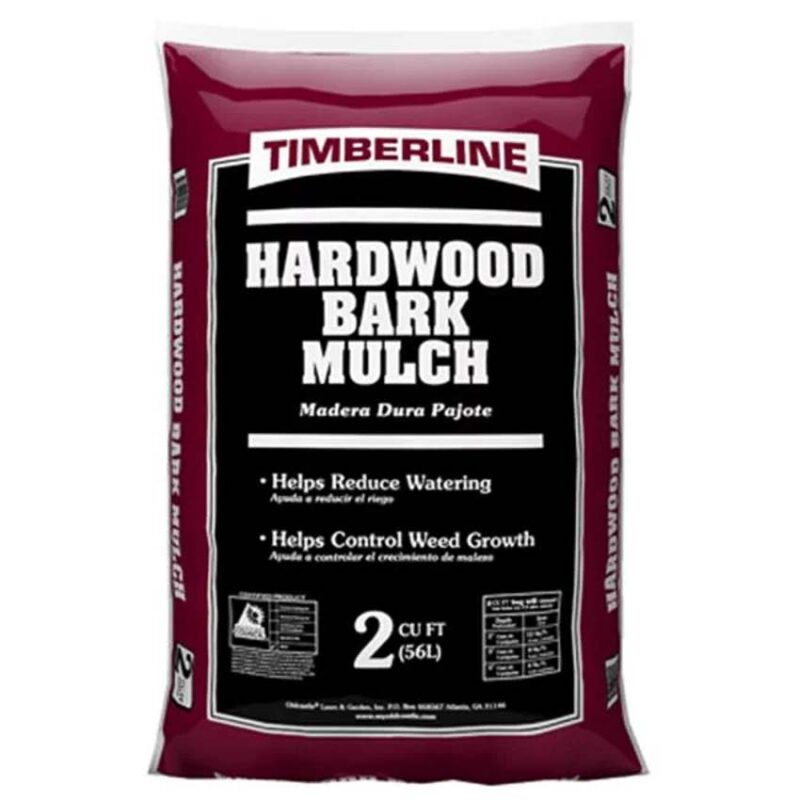
Choose ground covers like bark mulch and patio pavers to keep your dog from digging. Most dogs dig out of boredom or to get cool, so providing them with plenty of exercise and a shady spot to relax will help.
What type of fencing is best for a dog friendly yard?
The best type of fencing for your dog depends on your dog’s habits and proclivities. Invisible dog fences are an excellent choice unless your dog has a strong prey drive.
How do I handle dog waste in my dog friendly landscape?
Cleaning up dog waste isn’t the best part of owning a dog, but it’s easy if you train your pooch to go potty in one area. Keep a pooper-scooper and a waste can nearby, and it will be less of a chore.
How can I make my pond or pool dog friendly?
Depending on the type of pond or pool you have and how much your dog loves the water, you might need a fence to keep your dog out. You can also build your pond raised above ground level. Providing dogs with their own easy-to-access pool will also help.

